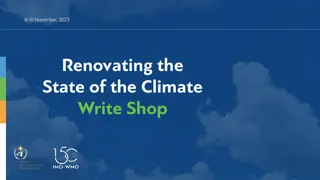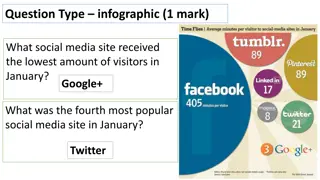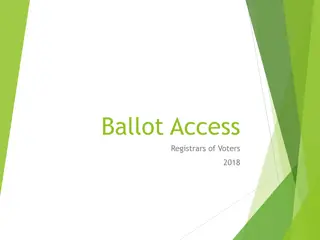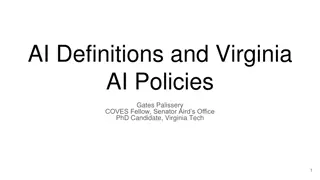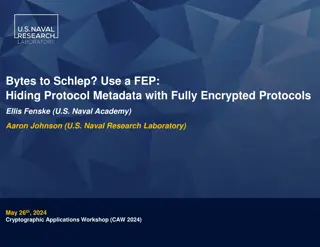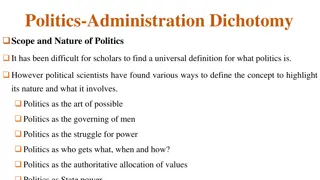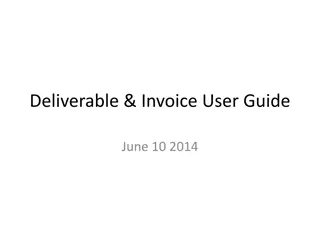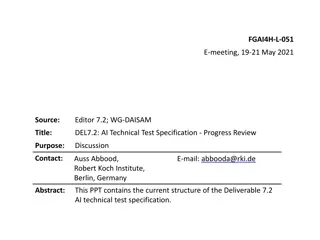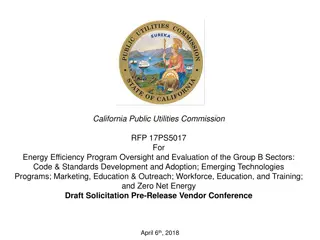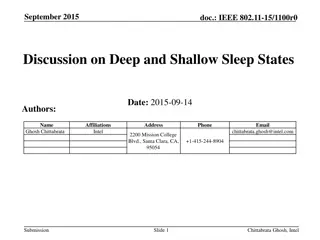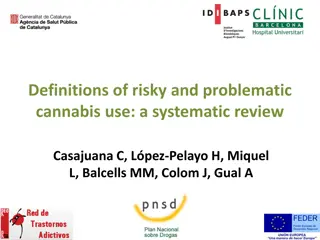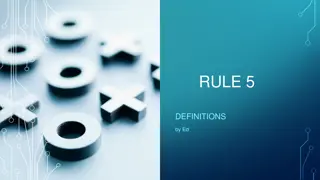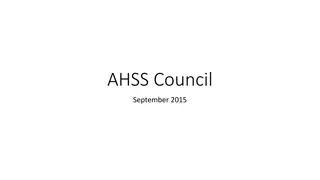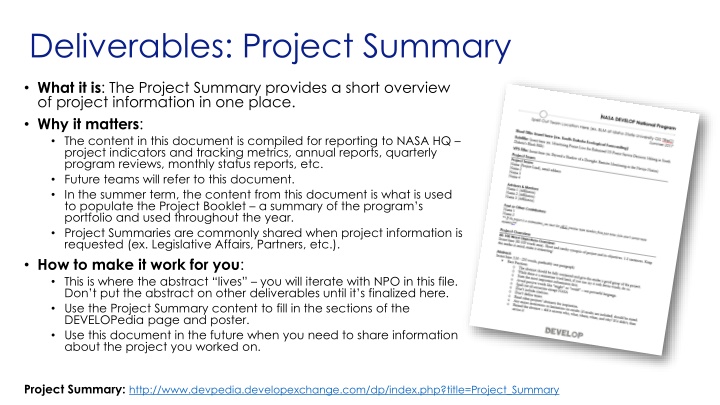
NASA Project Deliverables Overview for Effective Reporting
"Explore the essential NASA project deliverables including Project Summary, Tech Paper, Poster, and Presentation, vital for tracking metrics, sharing information, and showcasing project outcomes. Improve technical writing skills, engage with the scientific community, and enhance communication through these key components."
Download Presentation

Please find below an Image/Link to download the presentation.
The content on the website is provided AS IS for your information and personal use only. It may not be sold, licensed, or shared on other websites without obtaining consent from the author. If you encounter any issues during the download, it is possible that the publisher has removed the file from their server.
You are allowed to download the files provided on this website for personal or commercial use, subject to the condition that they are used lawfully. All files are the property of their respective owners.
The content on the website is provided AS IS for your information and personal use only. It may not be sold, licensed, or shared on other websites without obtaining consent from the author.
E N D
Presentation Transcript
Deliverables: Project Summary What it is: The Project Summary provides a short overview of project information in one place. Why it matters: The content in this document is compiled for reporting to NASA HQ project indicators and tracking metrics, annual reports, quarterly program reviews, monthly status reports, etc. Future teams will refer to this document. In the summer term, the content from this document is what is used to populate the Project Booklet a summary of the program s portfolio and used throughout the year. Project Summaries are commonly shared when project information is requested (ex. Legislative Affairs, Partners, etc.). How to make it work for you: This is where the abstract lives you will iterate with NPO in this file. Don t put the abstract on other deliverables until it s finalized here. Use the Project Summary content to fill in the sections of the DEVELOPedia page and poster. Use this document in the future when you need to share information about the project you worked on. Project Summary:http://www.devpedia.developexchange.com/dp/index.php?title=Project_Summary
Deliverables: Tech Paper What it is: The Tech Paper provides a synopsis of the project with technical details for partners and future DEVELOP teams to replicate and understand. Why it matters: Tech papers are the foundation for all future publications relating to the project. Tech papers are commonly shared with project partners. Methods are a large focus of the paper and should assist others in replicating your work. How to make it work for you: Develop your technical writing skills by working on the tech paper. Use content from the tech paper in the video, poster, and presentation. When you are applying to jobs and schools this can be shared as a writing sample. Important to Know: Any external distribution or publications of this work must go through NASA Export Control. Just contact NPO and they can confirm it s been approved. Tech Paper: http://www.devpedia.developexchange.com/dp/index.php?title=Tech_Paper
Deliverables: Poster What it is: the visual demonstration of your project. It should layout the important aspects of your project in an appealing and easy to understand manner. Why it matters: All projects are represented at the Summer Showcase at NASA HQ. Posters are commonly presented at node close out events at the end of the term. Poster presentations at conferences and recruiting are extremely common within DEVELOP. This deliverable will be shared with project partners. How to make it work for you: Content is often the same/similar to the presentation content save yourself some time and reuse! Effectively communicating your project visually can be hard, use the opportunity to create your poster to build your design skills. Presenting your work at a conference is an excellent opportunity to engage with the scientific community and a strong poster is key. Important to Know: All teams will submit a HQ Final Draft. Due to the showcase falling in week 9, this comes in earlier than final results sometimes. A final draft at the end of the term can include more results/outcomes or a team can submit the HQ poster as the final poster draft again. Interested in presenting your project at a conference? Talk to your Center Lead. Poster: http://www.devpedia.developexchange.com/dp/index.php?title=Poster
Deliverables: Presentation What it is: the story of your project laid out in a slide by slide progression. It should speak to all aspects of your project. Why it matters: Presentation skills are fundamental to effective communication of science. Presentations are commonly presented at the end-of-term node close out events. Content from presentations are often repackaged for recruiting presentations, conference presentations. This deliverable will be shared with project partners. Presentation content is commonly used in recruiting presentations to inform potential partners and participants about the type of projects we conduct. Presentations are used to report to NASA HQ in ASP Program Reviews and SMD Monthly Status Reviews. How to make it work for you: Presentation skills are critical having good content to practice those skills helps! The ability to craft a good PowerPoint presentation is important. Chartsmanship counts! Content is often the same/similar to the poster content save yourself some time and reuse! Presenting your work at a conference, in a classroom, or other events is fun and builds your skills and network. Important to Know: Some teams will be selected to present a highlight or flash talk at NASA HQ. Those teams will also submit a HQ FD. The template's layout is a guide, feel free to amend it to fit your project. A good practice is to have the presentation flow through the following: what was the problem, what did you do about it, and what is/will be the benefit and outcome. Presentation: http://www.devpedia.developexchange.com/dp/index.php?title=Presentation
Deliverables: Video & Transcript What it is: the story of your project in video. It highlights your project s purpose to the project partners, scientific community, and the general public. Why it matters: It is the most external facing deliverable. NASA HQ puts a strong emphasis on the power of these videos. All project videos are hosted on DEVELOP s YouTube channel. The video archive hosts over 500 project videos from 2011 to the present it s an amazing archive! Many partner organizations will support your video creation by submitting clips and interviews they then will highlight the video on their websites and social media because it brings attention to their needs. How to make it work for you: Video creation skills are a really unique skillset to add to your r sum and science communication tool belt. You can link to your team s video on LinkedIn, social media, r sum s, job applications, etc. Important to Know: This an opportunity for the team to explore their creative sides. We do have to represent NASA well so keep it professional! The transcript is mandatory, as the video must be compliant with Section 508 of the US Rehabilitation Act. Requirements have changed over the years due to NASA Legal requirements if you have any questions if something is alright, reach out to the Comm Team @ DEVELOP.Communications@gmail.com first. Video: http://www.devpedia.developexchange.com/dp/index.php?title=Virtual_Poster_Session
Deliverables: Imagery What it is: There are two different images the team will submit, each serves a unique purpose and will be used for external communication. Website Image: Used for the DEVELOP website project page gallery, VPS video thumbnail, and ASP website project portfolio. Technical Image: Also used on the DEVELOP website project page, and the interactive web mapper. Why it matters: These images are used for website project pages, summer booklet, video thumbnails, and the ASP website. How to make it work for you: The ability to make effective visualizations of your work can increase the resonance of your project and attract viewers. Important to Know: The website image should not have any text on the image as it will be viewed at multiple scales and it would be distorted. The website image comes in early in the term due to the fact NPO needs time to build web pages and post in the VPS. The technical image can have legends and text, but be sparing and make sure it s effective! 6 Website Image Examples Technical Image Example Imagery: http://www.devpedia.developexchange.com/dp/index.php?title=Website_and_Technical_Imagery
Deliverables: Study Area Shapefile What it is: The shapefile outlines the study area and is used for the creation of impact maps and congressional district maps. Why it matters: This deliverable allows us to show how our program benefits the taxpayer, giving insight into where we are increasing workforce development and building capacity to use NASA Earth observations. Maps will be used by NASA's Applied Sciences when reporting to members of Congress, and it is thus extremely important that these maps accurately reflect the extent of our projects impact. This shapefile is used in the creation of impact maps and the new interactive web mapper to discern project study areas. How to make it work for you: The ability to package shapefiles and share is helpful and you can reuse this shapefile in the future. Important to Know: Your shapefile must match the study area listed on your project summary. Create a polygon shapefile of your study area, containing only one feature. Attribute table should contain a project field where your project short title is listed. The shapefile must be zipped and saved using standard file nomenclature. Coordinate system: GCS_WGS_1984 If through the course of the project, your study area changes to include additional states/countries not originally listed, ALL deliverables must be updated to reflect that change (even after a FD has been submitted). Shapefile: http://www.devpedia.developexchange.com/dp/index.php?title=Study_Area_Shapefile
Deliverables: DEVELOPedia Project Page What it is: Each project has a page on DEVELOPedia that is accessible to future DEVELOPers. Why it matters: DEVELOPedia serves as the most complete project archive available this is a resource to everyone in the program. How to make it work for you: You can refer back to this page at anytime as DEVELOPers get to keep their accounts for eternity. After a final NPO review, a final, archival set of deliverables are posted and you can access as needed. DEVELOP Website Project Pages Project pages are posted near the end of term on the NASA DEVELOP website. Feature your experiences and project pages on LinkedIn.
Deliverables: Feedback Form What it is: The newest deliverable is in response to NASA Headquarter s request that we increase our collection and reporting of feedback relating to three things: 1) NASA Earth observation data (accessibility, processing, and use), 2) research questions surfaced by application projects (what do the feasibility study results lead our partners to pursue next), and 3) partner engagement. Headquarters is also collecting information relating to answering the question what is your success rate? driving DEVELOP to increase its reflection on and assessment of projects and resources expended. With this in mind, DEVELOP has created a simple template that collects information regarding the above topics, along with team and advising relating to each project. Why it matters: Headquarters is looking for the wealth of knowledge rapidly gained in DEVELOP projects to feed into Science Teams How to make it work for you: Team discussion relating to the challenges and data use is a great exercise for the team to pursue. Follow up with project partners is also an important facet to the relationships built. Important to Know: This is the newest deliverable and we are looking for guidance on additional instructions we can provide.
Deliverables: Optional Deliverables What they are: Your team may have extra time or decide that the creation of an optional deliverable will be of high-value. In this event, your team can utilize the resources and templates provided below to help create an excellent deliverable. Examples of optional deliverables are tutorials, one-pager/brochure, or image gallery, but really this is anything additional the team creates as part of a package for the partners. Why it matters: Often project partners can benefit most from a tutorial or additional materials that highlight the project s methodology. How to make it work for you: Brochures can be used at conferences to hand out at poster presentations or given to partners to increase awareness of the project. Tutorials can be referenced later on and you can submit as sample work when applying for a job or to graduate school. Important to Know: Before diving into this head-first, make sure the optional deliverables will not decrease the quality or timeliness of required deliverables. Participants are paid by the submission of required deliverables and optional deliverables are completely optional. However, they can be extremely useful for your team, the end-user or boundary org, and for the community, so it s generally a good idea to discuss this possibility earlier in the term. Optional Deliverables: http://www.devpedia.developexchange.com/dp/index.php?title=Optional_Deliverables
Deliverables: Code What it is: Teams are expected to turn in code that they developed for their projects. This can be any code that was used to help the project, such as batch processing imagery or converting files to a different format. Code is collected at the end of the term and will be put into a repository shared only among DEVELOP. Why it matters: Code can increase efficiency and speed up processing. Many projects follow similar processing and analysis steps and can benefit from each others code. How to make it work for you: Code created at DEVELOP can be used in future work, although if it would be shared outside NASA and beyond your personal use, it must go through the software release process Important to Know: This deliverable applies to all code code going through software release & internal code (NEW!) If a team does not plan to create any code, contact the Geoinformatics Team and opt-out Final code with README is submitted in week 10 Code with README: http://www.devpedia.developexchange.com/dp/index.php?title=Code_with_README

